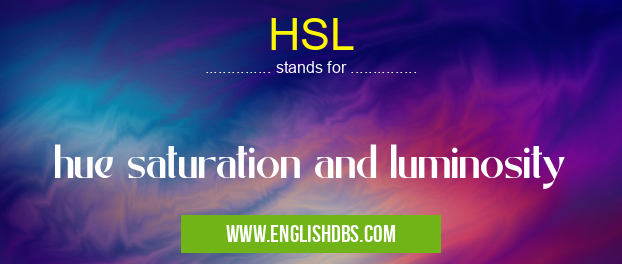What does HSL mean in UNCLASSIFIED
HSL stands for Hue, Saturation, and Luminosity. In computing and other related fields, these three terms are often used to describe the colors of an image or a digital media file. The purpose of HSL is to give users the ability to quickly adjust the color scheme of an image without having to manually change individual values. It allows for fine-tuning adjustments in order to maintain color consistency across multiple images. Furthermore, it helps users create more aesthetically pleasing images, as adjustments can be made based on personal preferences.

HSL meaning in Unclassified in Miscellaneous
HSL mostly used in an acronym Unclassified in Category Miscellaneous that means hue saturation and luminosity
Shorthand: HSL,
Full Form: hue saturation and luminosity
For more information of "hue saturation and luminosity", see the section below.
What is HSL?
HSL stands for Hue, Saturation and Luminosity. It is a way of expressing color in digital form which describes the different components that make up a particular hue (color). It is different from RGB (Red-Green-Blue) which uses three channels – red, green, and blue – in order to express a color. Instead, HSL uses hue, saturation and luminosity as the three main components which together result in more accurate representations of how we perceive colors in the real world.
How it works
Hue refers to the overall shade/tint or tone that makes up a color. Generally speaking, hues can run from 0 to 359 degrees on a color wheel; with red being 0° at one end and 360° at its opposite end (the same exact shade). Saturation defines how pure or intense a certain hue looks; with 0% giving off nothing brighter than gray shades (achromatic) all the way up to 100%, where hues look their most vivid and distinct from any other shades next to them. Lastly comes luminosity which affects the levels of brightness or darkness within an image; ranging from 0% (black) all the way up to 100% (white).
Implication for MISCELLANEOUS
In MISCELLANEOUS, HSL can be especially useful when creating logos or designs which need specific colors - like company branding - as it allows precision adjustments so that users can ensure their preferred colors are perfectly represented throughout all applications they might use across multiple platforms. Other benefits include simpler selection of complementary colors while avoiding monotony by incorporating subtle variations with minimal effort; no matter if those colors are part of web design elements such as backgrounds/ text or even marketing designs such as posters and flyers!
Essential Questions and Answers on hue saturation and luminosity in "MISCELLANEOUS»UNFILED"
What Is HSL?
HSL stands for hue, saturation and luminosity. It is a color model used to describe colors in terms of their hue, saturation and brightness values. This makes it easier to identify colors, create gradients and adjust the intensity of different parts of an image.
How Do Layers Work With HSL?
In graphics software like Adobe Photoshop or Illustrator, it is possible to create layers that hold information about the hue, saturation or luminosity of an image. This allows you to make adjustments at a lower level without affecting other colors or elements in the image.
What Are Hue, Saturation And Luminosity?
Hue is essentially the color name itself; red, yellow, green etc. Saturation is how pure or intense the color is – if it’s bright or muted - while luminosity is how bright or dark the color appears on a scale from 0-100%.
What Is Color Temperature?
Color temperature refers to the warmth or coolness of a light source in relation to how its brightness affects the overall visual tone of an image. The lower the Kelvin number (K), the warmer it looks; for example “daylight” has a much higher K rating than “tungsten” lighting.
How Does HSL Affect Image Adjustments?
Adjusting parameters such as hue, saturation and luminosity can have a big effect on an image's overall tone and atmosphere. Increasing hue values can add more vibrance while decreasing them can help soften colors; increasing brightness will make everything look more vibrant while lowering it will give things a more subtle look.
What Is A Gradient Map?
A gradient map is a method of creating color gradients using hue information instead of just RGB values (red-green-blue). This allows for much more precise control over blending between two or more colors when creating digital artworks in software like Photoshop.
Why Do Graphic Designers Use Hue Shifts?
By using subtle shifts in hue - such as adding blues instead of greens - artists can achieve results that would be difficult with traditional approaches like mixing paintbrushes together with primary colors. It also makes it easier to adjust entire images with just one adjustment layer instead of multiple separate ones.
Can I Adjust Brightness Without Affecting Other Colors?
Absolutely! By isolating changes in either hue/saturation or luminosity, you can make global improvements to your images without adversely affecting any existing details or tones within them.
